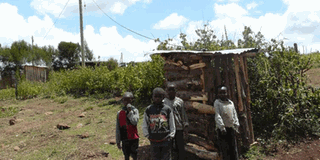Affordable and reliable power is a human right

Electricity connection in Kenyan countryside. PHOTO | FILE | NATION MEDIA GROUP
What you need to know:
- World Bank statistics show the sub-Saharan region, with a population of one billion, generates 68 gigawatts, the same as Spain, which has 60 million people.
The McKinsey Global Institute says Africa’s solar energy potential is about 11 terawatts, enough to light the continent 250 times over.
Luckily, Kenya has deliberately leveraged its renewable energy resources and is a leader in geothermal and wind power generation.
Now that Kenya is producing more electricity than it can consume, focus should be on reducing the cost of power and making supply reliable.
IMPROVE LIVELIHOODS
A key factor in China’s phenomenal industrialisation is inexpensive power. In East China, electricity is applied even in basic agricultural activities such as tilling land.
As we are now learning, it is one thing to produce enough electricity and another to benefit from it. Affordable and reliable power catalyses economic growth and creates jobs, improving livelihoods.
Compared to other developing regions, energy generation and supply in Africa is too little to make a meaningful impact on people’s lives. World Bank statistics show the sub-Saharan region, with a population of one billion, generates 68 gigawatts, the same as Spain, which has 60 million people.
Kenya boasts the third-biggest electricity expansion: Electrification is about 76 per cent, also the highest in East Africa. It produces 2,700 megawatts against a demand of 2,000MW. But there are critical problems.
The World Energy Council cites inadequate infrastructure, high prices, inadequate personnel, funding and poor regulatory frameworks (leading to corruption) as the main obstacles to the full benefits of enhanced electrification.
IDLE POWER
That Kenyan consumers have to pay for idle power is an example of bad governance. Despite the enhanced electrification, Kenyans regularly experience the impact of all these problems mostly in blackouts and low voltage.
And it’s worse elsewhere in Africa: Blackouts in parts of Lagos, Nigeria, can last weeks, even months. Some schoolchildren in Conakry, Guinea, use street lights to study at night.
Without affordable and reliable power supply, people turn to the most cost-effective sources: Charcoal, firewood and other biomass energy sources for cooking and heating. Even the urban well-to-do will have a charcoal burner.
A substantial reduction in the cost of power could help to alleviate many of Kenya’s economic and health challenges. For instance, we need cheaper power to refrigerate vaccines and other temperature-sensitive medicines. Cheaper power translates to less reliance on erratic rain for agriculture.
CLEANER WATER
It also means cleaner cooking facilities. About 6,000 people, mainly in Africa, die of respiratory diseases caused by kitchen fumes due to inefficient burning of biomass.
Cheaper energy would translate to cleaner water. The UN says waterborne diseases kill more people than war and terrorism.
Reducing the cost of power needs a multifaceted approach. There should be policies to subsidise inexpensive energy mixes. Kenya’s energy policy is jumbled, mostly leaning on intent rather than action.
Renewable energy is the future. The McKinsey Global Institute says Africa’s solar energy potential is about 11 terawatts, enough to light the continent 250 times over. Luckily, Kenya has deliberately leveraged its renewable energy resources and is a leader in geothermal and wind power generation.
CLEAN HIGH-HEAT
With the prices of electricity too high for ordinary people, biomass will remain the only choice for some time. The problem is not burning biomass per se, but the inefficiency of cooking appliances.
Traditional biomass burners, like the traditional three stones, are slow and polluting. But we can promote gasification — that is, converting biomass to combustible gas. Gasifier stoves are already in the market. Modern ones can convert wood chunks, leaves, sawdust and so on to clean high-heat gas.
Alternatives like biogas should also be encouraged.
But the cost of equipment for small-scale renewable energy remains high. The Jua Kali should be aided to make cheaper ones, in line with the UN millennium energy projects.
Without a deliberate government effort to reduce power costs, initiatives like Feed-in Tariff (FiT), meant to encourage independent power producers to sell renewable energy, will fail.
CARBON EMISSIONS
A USAid report recommends a shift of focus to promoting energy efficiency. Kenya can take a leaf from Ghana’s appliance labelling programme, which makes a consumer aware of the energy efficiency of a product, saving a lot of money while reducing carbon emissions — which can, in turn, generate income in the carbon trade market.
The government must put money on Kenya Electricity Transmission Company. Ketraco's inability to transmit power imposes high costs on consumers, especially small-scale users. Youthful entrepreneurs are the worst hit by this.
The government should start treating cheaper energy as a human right and not a favour. China is an economic powerhouse because it realised this 30 years ago.
Dr Mbataru (PhD) teaches at Kenyatta University. [email protected].





